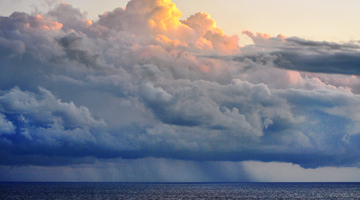In this video, Dave Campbell and Keith Hunter discuss what weather and climate are, and how the water cycle is key to the weather. Weather describes the condition of the air masses overlying land and sea. Climate refers to a pattern of weather over a period of time (such as a season). Weather is the ‘here and now’, while climate is an accumulation of many days’ or even years’ worth of information about the weather.
Weather and climate are complex processes with many influences: solar radiation, the tilt of the Earth’s axis, landscape (including buildings and cities), seasons, time of day and human activities. Approximately half of the incoming solar radiation is used in evaporating water to the atmosphere. This water then becomes our weather, which can then recharge water resources of the rest of the planet through precipitation
Points of interest: Find out what latent heat is and why it is important. What is the source of heat energy that drives the water cycle?
Transcript
PROF DAVID HAMILTON
The weather and climate are what we call meteorological variables, and they will include important things such as radiation or sunshine, wind, humidity and air temperature of course.
NARRATOR
The water cycle is driven by energy from the sun. Liquid water is evaporated and changed into a gas. This vapour rises and circulates in the atmosphere, cools and changes back into a liquid. This process is called condensation. Tiny droplets of water in the atmosphere accumulate to form clouds, which then return the water to Earth as rain or snow. The rate of evaporation depends on 4 main conditions – water body size, heat energy, atmosphere pressure, and air movement.
PROF KEITH HUNTER
The ocean has a dominant influence on climate and temperature. The process of evaporation of seawater near the equator transfers water vapour to the atmosphere, and ultimately recharges all of the water resources on the rest of the planet. But along with that water, the one thing you have to do if you want to convert liquid water into water vapour is you have to provide heat energy, and the heat energy is held within the molecules of water while they are present in the gas phase, and we call that latent heat
NARRATOR
The sun is the source of the heat energy that drives the water cycle and, in turn, influences the weather and climate.
DR DAVE CAMPBELL
Roughly a half of the solar radiation that is absorbed at the Earth's surface is used up in evaporating water – in other words, converting water from its liquid form to water vapour as a gas in the atmosphere. So when we talk about a hydrological cycle – which is the movement of water from the surface into the atmosphere, and then it condenses and forms precipitation, falls out as either rain or snow onto the land or ocean surface and then moves back into the ocean if it’s coming off the land.
PROF KEITH HUNTER
And when the water vapour condenses back into rain again, then that latent heat is released as heat energy, and it’s that heat energy which drives the wind systems of the atmosphere. It’s that heat energy that causes hurricanes. So if you get a warm period in the Gulf of Mexico, where you get lots of evaporation, then you get hurricanes being formed, and they are at the extreme end of the climate spectrum. But basically wind is created largely by this exchange of heat energy that results from the condensation of water that has come from the ocean.
Acknowledgements:
Prof. David Hamilton, Waikato University
Prof. Keith Hunter, Otago University
Dr David Campbell, Waikato University
Sun image, Lykaestria, licensed under Creative Commons
Globe image, courtesy of NASA
Wind computer model, Peyman Zawar-Reza, University of Canterbury
Christchurch smog image, Dr Simon Kingham, University of Canterbury



